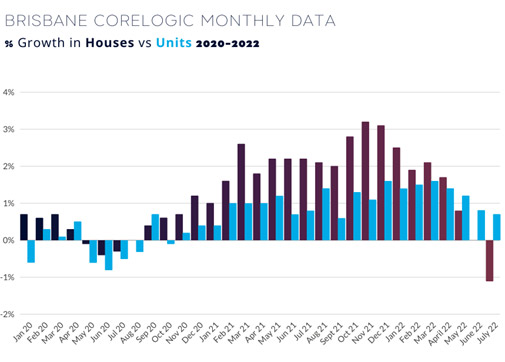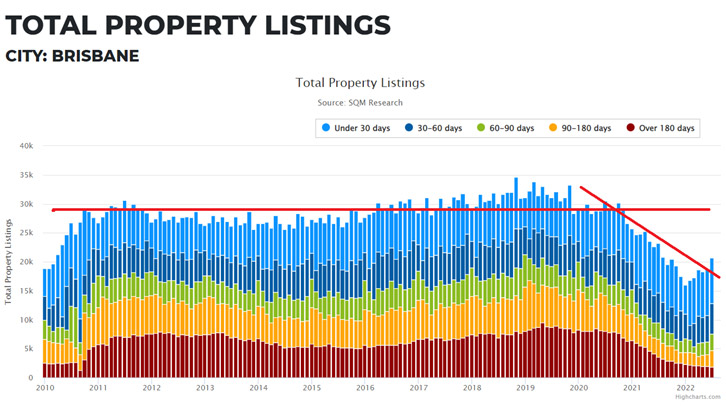Brisbane unit and house prices head in opposite directions
Property prices may be edging downwards overall in Brisbane after an extended period of rapid growth but some property types are still increasing in value.
The Brisbane property market is diverging between houses, which are in decline, and units and townhouses that are continuing to grow.
A large portion of buyers appear fearful and are sitting on the sidelines observing rather than bidding on properties. Other buyers are gearing up to take advantage of any opportunities that the current conditions might present.
Brisbane dwelling values fell 0.8 per cent in July.
The retraction is not as great as the fall in median values in Sydney (- 2.2 per cent), Melbourne (- 1.5 per cent), Hobart (- 1.5 per cent), and Canberra (- 1.1 per cent). Other capital cities including Adelaide, Perth and Darwin showed small growth rates in median values across the same period.
It is clear, that the slowdown in property price growth throughout Australia coincided with the onset of the first interest rate hike in May and the resultant change in consumer sentiment has been obvious.
With consumer sentiment being pushed to new lows in July it is apparent that both the rate and the pace of the deterioration are comparable to previous major shocks such as the Global Financial Crisis and the onset of the pandemic.
Respondents who were part of the most recent Westpac consumer sentiment survey identified inflationary pressure, interest rates, the domestic economy and international conditions as their major concerns.
Property types diverging
The rate of change in median value trends over the last couple of months has been more evident in the housing market, compared to the unit/townhouse market in Brisbane. Median values for houses across Greater Brisbane declined 1.1 per cent in July. The current median value for houses is $884,336 which is $7,797 lower than last month.
In the unit market in Brisbane, however, the median value increased in July by 0.7 per cent. The current median value for Brisbane units is now $504,520, which is $3,446 more than last month.

The shift in demand over recent months away from housing and towards quality townhouses and units has been stimulated by affordability constraints due to the rapid growth in Brisbane house prices over the last 18 months.
A $500,000 budget used to be sufficient for a reasonable house on its own lot within 30km of the CBD but that budget typically now needs to be a lot higher.
Instead of shifting further and further away from the CBD to buy a house with a similar budget, buyers have been choosing to compromise on the type of property and look for townhouse or unit options much closer to inner-city locations.
This shift in demand is a trend that is also observed through the data.
From April this year, the unit market has outperformed the housing market in terms of monthly median price growth in Brisbane.
This month, despite negative house price growth for the first month in two years, the unit segment of the market continued to see value growth.
Advantage Brisbane
Brisbane retains many advantages over Sydney and Melbourne.
Firstly, Brisbane has a relative affordability advantage, which has been the case for many years.
Despite the gap narrowing over the most recent growth cycle, there remains a significant affordability advantage for property buyers in Brisbane in the housing sector as well as the unit sector of the market. This places Brisbane in a better position to ride out the uncertainty in the months ahead.
Additionally, with rents on the rise due to record low vacancy rates, Brisbane is leading the growth for capital city housing rents, with more upward pressure likely in the months ahead.
CoreLogic data shows the annual change in house rents in Brisbane is 13.6 per cent and the annual change in unit rents is 9.7 per cent. We have observed rents in some areas jump more than 20 per cent in the last 12 months alone and there is no slowdown in sight. This is also having a positive effect on yields, with gross yields in Brisbane now 3.4 per cent for houses and 4.7 per cent for units.
The vacancy rate in Brisbane according to SQM Research is at 0.6 per cent.
Even locations where vacancy has been elevated for many years due to the oversupply of higher density unit developments, there has been a rapid recovery and take-up of occupancy by tenants.
| Region | Vacancy rate (June 2022) |
|---|---|
| Beenleigh corridor | 0.4% |
| Brisbane CBD | 1.3% |
| East Brisbane | 0.7% |
| Inner Brisbane | 1.0% |
| Ipswich | 0.5% |
| North Brisbane | 0.4% |
| South-East Brisbane | 0.4% |
| Southern Brisbane | 0.7% |
| West Brisbane | 0.6% |
It is expected that the rate of international migration will rapidly escalate in the summer months, adding more pressure to the rental market. Additionally, with the rate of interstate migration still elevated, the rental supply issue appears to be a continuing concern.
The Queensland capital is now also contending with the state government’s new land tax changes, whereby property investors who have landholdings in the same name outside Queensland will be burdened with higher rates of land tax from 30 June 2023.
This is yet another disincentive for private investors, who are the main supply driver of rental accommodation for tenants. Legislative changes like this could have further long-term impacts on the supply of rental accommodation, which will ultimately result in escalating costs for tenants in the medium to long term.
Supply is also suppressed in the sales market in Brisbane.
The number of properties available for sale is still well below the long-term average in Brisbane, whereas in Sydney and Melbourne the opposite is now true. Total listing volumes in those cities are now back to, or above, the long-term trend.

With rising interest rates, buyers are losing some of their borrowing capacity. This combined with inflationary pressure is eroding buying confidence.
Those with pre-approvals are having to determine with each monthly rate increase if those pre-approvals are in fact still valid. Despite rising interest costs, there is no real evidence of forced selling in Brisbane.
With such a strong labour force, forced selling is not expected in the immediate future.
Over the last 12 months, Queensland led the way with a solid 4.6 per cent increase in the number of employed persons and the unemployment rate has now plummeted to just 3.5 per cent, which is the lowest figure since the monthly data series began in 1974.
As the Brisbane market transitions, there are expected to be some good buying opportunities for those who maintain a long-term focus.
For those who have no urgency to sell, days on market are trending higher as the standoff between buyers and sellers unfolds.
The months ahead will be an interesting ride.
















